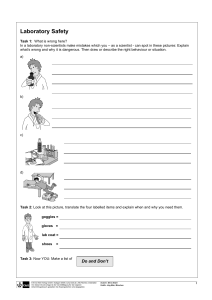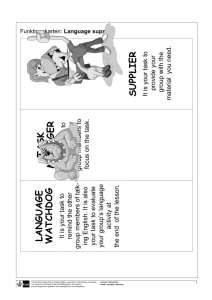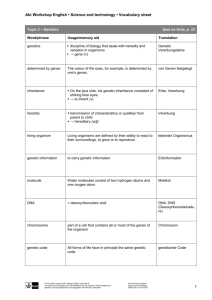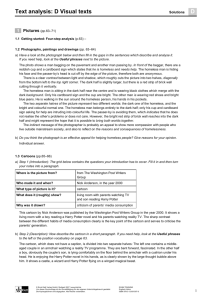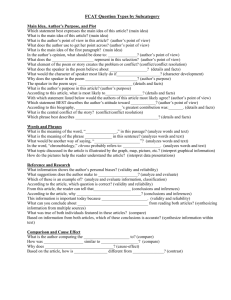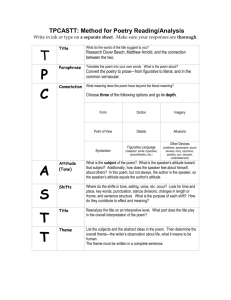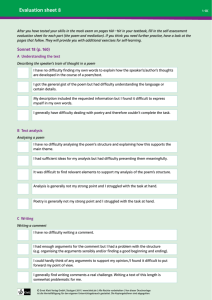South Africa – The Rainbow Nation Evaluation sheet 3
advertisement
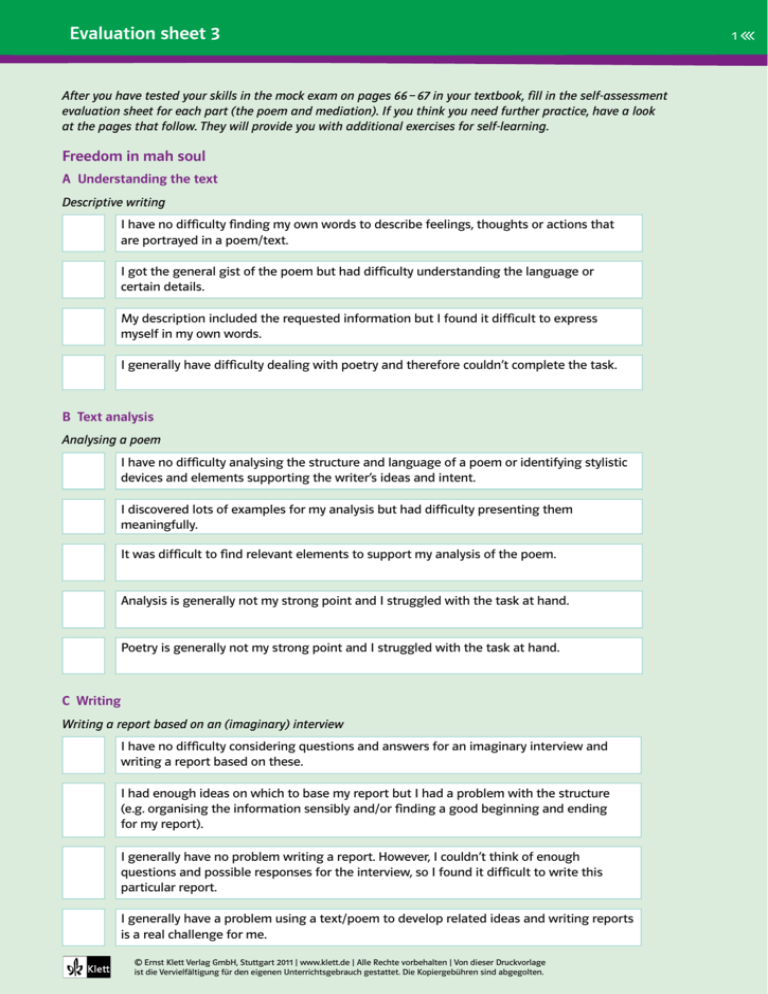
1 Evaluation South Africa sheet – The3 Rainbow Nation After you have tested your skills in the mock exam on pages 66 – 67 in your textbook, fill in the self-assessment evaluation sheet for each part (the poem and mediation). If you think you need further practice, have a look at the pages that follow. They will provide you with additional exercises for self-learning. Freedom in mah soul A Understanding the text Descriptive writing I have no difficulty finding my own words to describe feelings, thoughts or actions that are portrayed in a poem/text. I got the general gist of the poem but had difficulty understanding the language or certain details. My description included the requested information but I found it difficult to express myself in my own words. I generally have difficulty dealing with poetry and therefore couldn’t complete the task. B Text analysis Analysing a poem I have no difficulty analysing the structure and language of a poem or identifying stylistic devices and elements supporting the writer’s ideas and intent. I discovered lots of examples for my analysis but had difficulty presenting them meaningfully. It was difficult to find relevant elements to support my analysis of the poem. Analysis is generally not my strong point and I struggled with the task at hand. Poetry is generally not my strong point and I struggled with the task at hand. C Writing Writing a report based on an (imaginary) interview I have no difficulty considering questions and answers for an imaginary interview and writing a report based on these. I had enough ideas on which to base my report but I had a problem with the structure (e.g. organising the information sensibly and/or finding a good beginning and ending for my report). I generally have no problem writing a report. However, I couldn’t think of enough questions and possible responses for the interview, so I found it difficult to write this particular report. I generally have a problem using a text/poem to develop related ideas and writing reports is a real challenge for me. © Ernst Klett Verlag GmbH, Stuttgart 2011 | www.klett.de | Alle Rechte vorbehalten | Von dieser Druckvorlage ist die Vervielfältigung für den eigenen Unterrichtsgebrauch gestattet. Die Kopiergebühren sind abgegolten. 1 Evaluation sheet 3 Violence was their answer Mediation (p. 67) Note-taking for a summary I understood the text fully and was able to take notes in English for a summary in German without any major problems. I included all the necessary points. I got the general gist of the text, but it took me a long time to decide which points should be included in a summary. My summary included all the necessary information but I found it difficult to express myself in German. I missed some important aspects or my notes included unnecessary information. I couldn’t understand the text and therefore had a problem summarising it. © Ernst Klett Verlag GmbH, Stuttgart 2011 | www.klett.de | Alle Rechte vorbehalten | Von dieser Druckvorlage ist die Vervielfältigung für den eigenen Unterrichtsgebrauch gestattet. Die Kopiergebühren sind abgegolten. 2 Exam training 3 Freedom in mah soul (p. 66) A Understanding the text a) Write the poem in prose form (in full sentences and using Standard English instead of dialect). Start like this: I’m going to get forty acres of land, just for myself! And with that – freedom in my soul! b) Highlight the words or phrases in your prose version of the poem that suggest the speaker is optimistic. Can you find any pessimistic references to the past, present or future in the poem? If so, mark these, too. B Text analysis a) Consider the structure of the poem – number and length of stanzas. How are the speaker’s thoughts divided up and thus reflected within this structure? b) What does the language of the poem suggest about the speaker’s background? What effect does this have on the reader/listener? c) Examine the poem for rhyme, rhythm, tone, exclamation, repetition, etc. Write down your examples. What do all these stylistic elements evoke in the reader/listener? © Ernst Klett Verlag GmbH, Stuttgart 2011 | www.klett.de | Alle Rechte vorbehalten | Von dieser Druckvorlage ist die Vervielfältigung für den eigenen Unterrichtsgebrauch gestattet. Die Kopiergebühren sind abgegolten. 3 Exam training 3 4 C Writing Writing a report based on an (imaginary) interview: 1. Before you write your report: Make a mind map about what we find out about the speaker in the poem to develop his/her character. speaker 2. Collect ideas in note form about what the speaker hopes and fears might be for the future of African Americans. TIP: Keep to the speaker’s language, style, tone and character when inventing the answers. Violence was their answer Mediation (p. 67) 1. Read the introduction and consider who is meant by “their” in the heading. Who was for peaceful means? 2. What do we learn about Alabama? What was King’s response to the status quo there? 3. What did this response lead to and how did it come to a head? © Ernst Klett Verlag GmbH, Stuttgart 2011 | www.klett.de | Alle Rechte vorbehalten | Von dieser Druckvorlage ist die Vervielfältigung für den eigenen Unterrichtsgebrauch gestattet. Die Kopiergebühren sind abgegolten. Solutions Exam training 3 Poetry (p.66) A Understanding the text a) – b) I’m going to get forty acres of land, just for myself! And with that – freedom in my soul! With high pines, hickories and oaks which can touch the sky, and with that – freedom in my soul! I can already see it: forty acres of land, with mule and plough, and cabin for four people, with a garden in front of my door, and with that – freedom in my soul! Then we’ll dig a deep well, which we’ll fill up with cool water, after that we’ll build a church and a school. This vision is great so let us head for the Promised Land. And with that – freedom in my soul. B Text analysis a) There are three stanzas. The first one has got five lines, the second one six, the third one seven. The content of the stanzas and the increasing number of lines correspond very well. It is as if the speaker paints a picture with his vivid language. He starts with the background and adds more and more detail so that it gets much more complex. The first stanza describes the place where the speaker wants to live. Each of the two statements is followed by the exclamation ‘And freedom in mah soul!’. In the second stanza the speaker portrays other things that are important for his life (a house, a garden, animals, etc.). Again he ends with ‘And freedom in mah soul’. Finally, he talks about bigger plans like building a church and school. The climax is reached (l. 16 – 17) in his praise of God for leading him to the ‘promised land’. He finishes again with ‘Freedom in mah soul!’. This time, however, it is not an exclamation which could be interpreted as a wish, but it is a simple statement. It seems as if he has found peace at last. Freedom to him is not much more than having a home, a place to live in peace and freedom in his soul which possibly suggests that he doesn’t want to feel hatred or revenge in his heart because of his hard life. b) The whole poem is written like a Black spiritual, a kind of song which was sung by the slaves who worked in the fields praying to God to release them from their hard destiny and dreaming of the ‘promised land’ where they would be as free as illustrated in the text. This is why the language the speaker uses is not Standard English. Instead he writes as he speaks because these songs were spread orally. Quite a number of letters are left out: ‘fo’ty (forty), fo’(for), an’ (and), lickin’ (licking), plow (plough), goin’ (going), do’ (door). There are also a number of spelling variations: jes’ (just), mah (my), de (the), enuf (enough), foah (four), den (then), dis (this), Lawd (Lord). Instead of writing ‘we have to’ the speaker says ‘we gotta’; instead of ‘is not’, ‘ain’t’. If he used Standard English, the message of the poem would possibly not be as intense as intended. c) The poem is like a spiritual, the last line of each verse repeated like a refrain. It consists of three stanzas in all. It has an unusual layout: The first one has got five lines, the second one six, the third one seven. It does not follow a clear rhyme scheme. The arrangement of the rhyme is abccb deeffg hijikkl. A number of lines do not rhyme at all. The poet aims to express the message of the speaker poetically. The vocabulary is quite simple; the words mainly belong to the word field of a prayer. The repetition of the phrase ‘freedom of mah soul’ creates an atmosphere of hope. The speaker repeats the phrase three times as an exclamation which could be interpreted as a wish. The fourth time it is a simple statement: He seems to have found peace at last. Also ‘fo’ty acres’ is repeated, underlying his need for his own land and freedom. The tone of the poem is joyful and intense. © Ernst Klett Verlag GmbH, Stuttgart 2011 | www.klett.de | Alle Rechte vorbehalten | Von dieser Druckvorlage ist die Vervielfältigung für den eigenen Unterrichtsgebrauch gestattet. Die Kopiergebühren sind abgegolten. 5 Solutions Exam training 3 6 C Writing Lösungsvorschlag 1. optimistic church provident believes in God speaker school ‘promised land’ hard-working 2. ‘cabin big enuf fo’ foah’ ‘freedom in ma soul’ – future will be better – a start towards equal opportunities (e.g. a piece of land for sustenance) – education for everyone – peaceful live, freedom, acceptance – living in freedom is not easy in the beginning Mediation (p. 67) 1. W.E.B. Du Bois, Malcolm X and their supporters are meant. By “their” Martin Luther King was against violence and pleaded for a non-violent movement. 2. Alabama was the US state which experienced the most violent attacks during the civil rights movement. King called Birmingham “the most thoroughly segregated city in the United States.” The civil rights movement challenged a statement made by the state’s governor, George Wallace, in which he promised that there will always be segregation in Alabama. King’s dream was to see black and white children hold hands and play together, even in Alabama. 3. This response led to violent attacks during peaceful marches. Black homes and churches were firebombed, demonstrators were sent to jail. The police fired tear gas on them, unleashed police dogs on children and used fire hoses to stop the marches. All this culminated in a bomb attack on the Sixteenth Street Baptist Church during a Sunday morning mass, murdering four young girls. © Ernst Klett Verlag GmbH, Stuttgart 2011 | www.klett.de | Alle Rechte vorbehalten | Von dieser Druckvorlage ist die Vervielfältigung für den eigenen Unterrichtsgebrauch gestattet. Die Kopiergebühren sind abgegolten.
